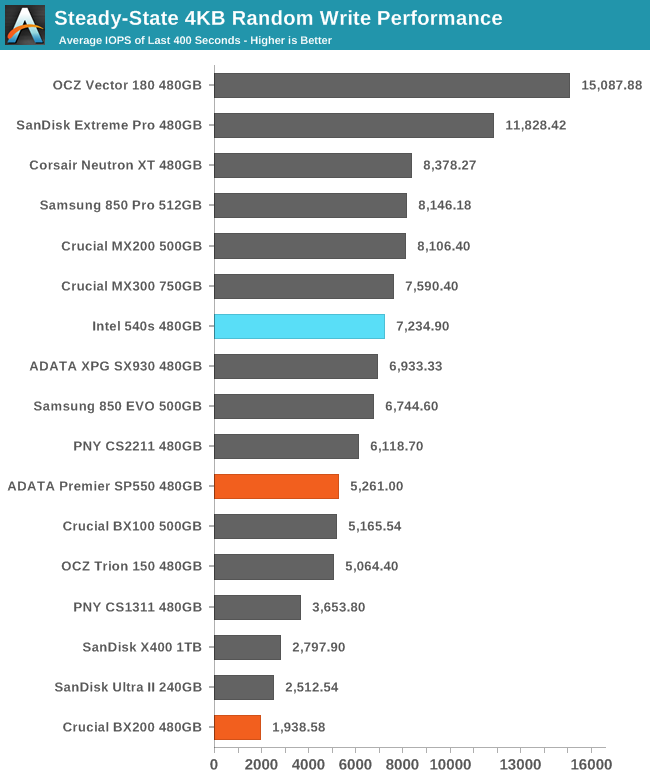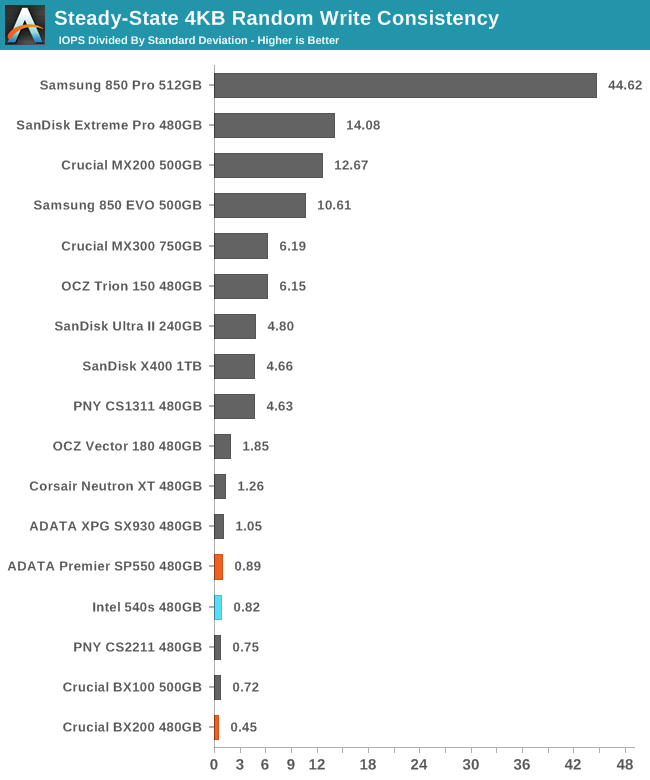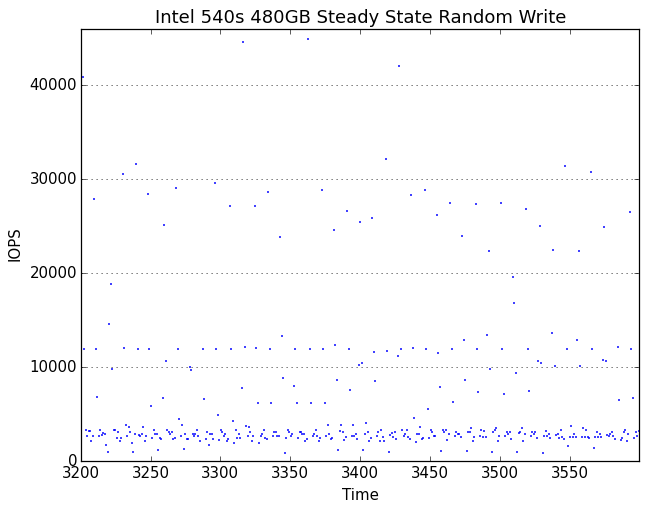The Intel SSD 540s (480GB) Review
by Billy Tallis on June 23, 2016 9:00 AM ESTPerformance Consistency
Our performance consistency test explores the extent to which a drive can reliably sustain performance during a long-duration random write test. Specifications for consumer drives typically list peak performance numbers only attainable in ideal conditions. The performance in a worst-case scenario can be drastically different as over the course of a long test drives can run out of spare area, have to start performing garbage collection, and sometimes even reach power or thermal limits.
In addition to an overall decline in performance, a long test can show patterns in how performance varies on shorter timescales. Some drives will exhibit very little variance in performance from second to second, while others will show massive drops in performance during each garbage collection cycle but otherwise maintain good performance, and others show constantly wide variance. If a drive periodically slows to hard drive levels of performance, it may feel slow to use even if its overall average performance is very high.
To maximally stress the drive's controller and force it to perform garbage collection and wear leveling, this test conducts 4kB random writes with a queue depth of 32. The drive is filled before the start of the test, and the test duration is one hour. Any spare area will be exhausted early in the test and by the end of the hour even the largest drives with the most overprovisioning will have reached a steady state. We use the last 400 seconds of the test to score the drive both on steady-state average writes per second and on its performance divided by the standard deviation.

Right from the start we see a substantial improvement of the SM2258 over SM2256, as steady-state random write speed has increased by 37%. This puts the Intel 540s well ahead of any other planar TLC drive and ahead of a few low-end MLC drives as well.

While the average random write speed has improved, the consistency is a bit worse and the Intel 540s scores in the bottom tier of drives. Phison's most recent generation of TLC drives managed to deliver very consistent steady state performance, but Silicon Motion still has a lot of room for improvement here.
 |
|||||||||
| Default | |||||||||
| 25% Over-Provisioning | |||||||||
The consistency of the 540s was clearly poor even before the transition to steady state, but during that early phase of the test it delivered twice the IOPS of the ADATA SP550.
 |
|||||||||
| Default | |||||||||
| 25% Over-Provisioning | |||||||||
Once in steady state, the 540s performance mostly stays slightly above the SP550. Both drives have frequent outliers beyond their band of usual performance, and the outliers are almost all in the direction of better performance. The Intel drive's outliers hit some much higher peaks than the ADATA SP550, suggesting that the new SM2258 controller may have significantly improved performance on bursty workloads.










77 Comments
View All Comments
Ananke - Thursday, June 23, 2016 - link
It is not the brand image, Intel is a government registered contractor, and it is US company, i.e. its products would be prioritized before price concerns.catavalon21 - Thursday, June 23, 2016 - link
Most USG computers are purchased all-up OEM systems (Dell, IBM, HP, etc.), and inclusion of a "foreign" SSD or HDD wouldn't slow down the purchase for a minute.Gigaplex - Thursday, June 23, 2016 - link
This barely qualifies as an Intel product. Other than firmware they didn't really build any of this.Vorl - Thursday, June 23, 2016 - link
So, you are defending overpriced crap because it's for government/corporate use? Wouldn't those same entities be better served with either cheaper similar performing options, or same priced better performing options?Honestly, you seem like you are defending them pretty hard and not using logic.
JoeyJoJo123 - Thursday, June 23, 2016 - link
I'm not defending it.Intel's milking their brand name, and more power to them. There isn't anything exactly evil for marking up your products because you have a global brand name (see: Apple, IBM, Beats, Bose, etc.)
Educated consumers like me and you are wiser than to buy this.
That being said, just because a smart consumer (again, you or I) shouldn't buy it, doesn't mean there's no point in releasing this SSD to the market. Let the sheeple buy them, you nor I should care about their choices in expenditures.
BurntMyBacon - Friday, June 24, 2016 - link
@JoeyJoJo123: "Let the sheeple buy them, you nor I should care about their choices in expenditures."Ideally no, we shouldn't. After all, if companies can make more money off of the "sheeple", then informed consumers can often times get a better value on another product that should by all rights be selling more if not for the "sheeple". However, letting the "sheeple" buy overpriced products from companies with a solid product line will sometimes encourage the company to overprice other products that informed consumers may have interest in. It's not always good for the informed consumer to leave the "sheeple" uninformed. Just don't get emotionally invested as it will almost certainly cause the opposite of the desired outcome.
vladx - Friday, June 24, 2016 - link
Indeed we should do our best and inform average joes about this kind of stuff whenever we can. This wat, more good products will be pushed instead of "trash" like this Intel SSD.catavalon21 - Thursday, June 23, 2016 - link
Fair enough on the corp / gov end use, though I have to wonder...who are they targeting with the 5 year warranty?euskalzabe - Friday, June 24, 2016 - link
Wait... how can you say that governments want to buy from "reputable" brands but then say that "brand image" doesn't count? If there's bad brand image, there's no reputation to talk about. They're essentially connected.JoeyJoJo123 - Monday, June 27, 2016 - link
Let me explain:Governments will make bulk purchases of resources they supposedly need. At one point the government purchases thousands of PS3s to network into a computing cluster. When the Pentium 4 came out, thousands of Pentium 4 computers were purchased by the government for government usage. Government entities seem to make these purchases primarily by brand recognition. Government entities rarely (if ever) purchase cheap Chinese PCs for official government usage, even though it would probably save them a lot of dough rather than procuring bulk workstations from HP/Dell/Lenovo, etc. Intel's a brand name and it's entirely feasibly that a Government IT sector office would procure bulk Intel SSDs to retrofit into slow/problematic workstations to prolong that workstation's lifespan, rather than purchase an entirely new workstation for that user.
On a personal level:
Never buy on brand name alone. Not every product a brand makes is great, and you shouldn't let good products that a company has made in the past cloud your judgment or decision on any particular other product. Unfortunately, Government procurements don't seem to follow this rationale.